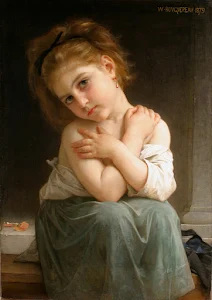The Shepherdess
The Shepherdess (French: Pastourelle), also known as The Little Shepherdess, is a painting by William-Adolphe Bouguereau completed in 1889. The title is taken from the Southern French dialect. The painting depicts an idyllic, pastoral scene of alone young woman in peasant attire posed for the artist, balancing a stick (likely her crook) across her shoulders, standing barefooted in the foreground. In the background are oxen grazing in a field.
It is one of many paintings by Bouguereau depicting shepherdesses, including one of the same name created in 1881. The subject is a model employed by Bouguereau for this and other paintings, including The Bohemian.
The Shepherdess is currently in the permanent collection at the Philbrook Museum of Art in Tulsa, where it has become an emblematic image for the museum. It was the central image of a travelling exhibition about Bouguereau and his students that Philbrook created in 2006.
Source and Courtesy : https://en.wikipedia.org/wiki/The_Shepherdess
Bouguereau’s career was nearly a direct ascent with hardly a setback. To many, he epitomized taste and refinement, and a respect for tradition. To others, he was a competent technician stuck in the past. Degas and his associates used the term "Bouguereauté" in a derogatory manner to describe any artistic style reliant on "slick and artificial surfaces", also known as a licked finish. In an 1872 letter, Degas wrote that he strove to emulate Bouguereau's ordered and productive working style, although with Degas' famous trenchant wit, and the aesthetic tendencies of the Impressionists, it is possible the statement was meant to be ironic. Paul Gauguin loathed him, rating him a round zero in Racontars de Rapin and later describing in Avant et après (Intimate Journals) the single occasion when Bouguereau made him smile on coming across a couple of his paintings in an Arles' brothel, "where they belonged".






















